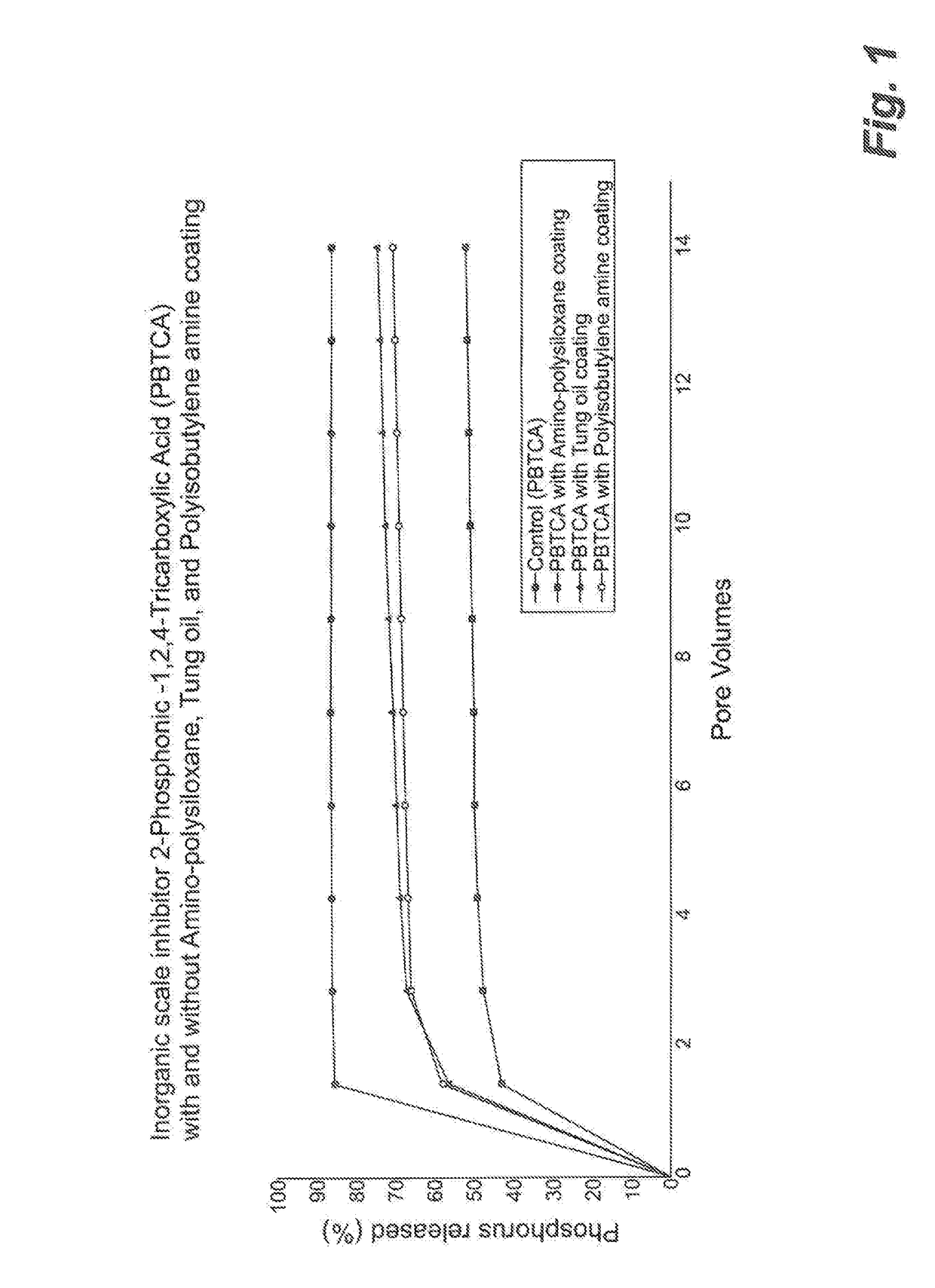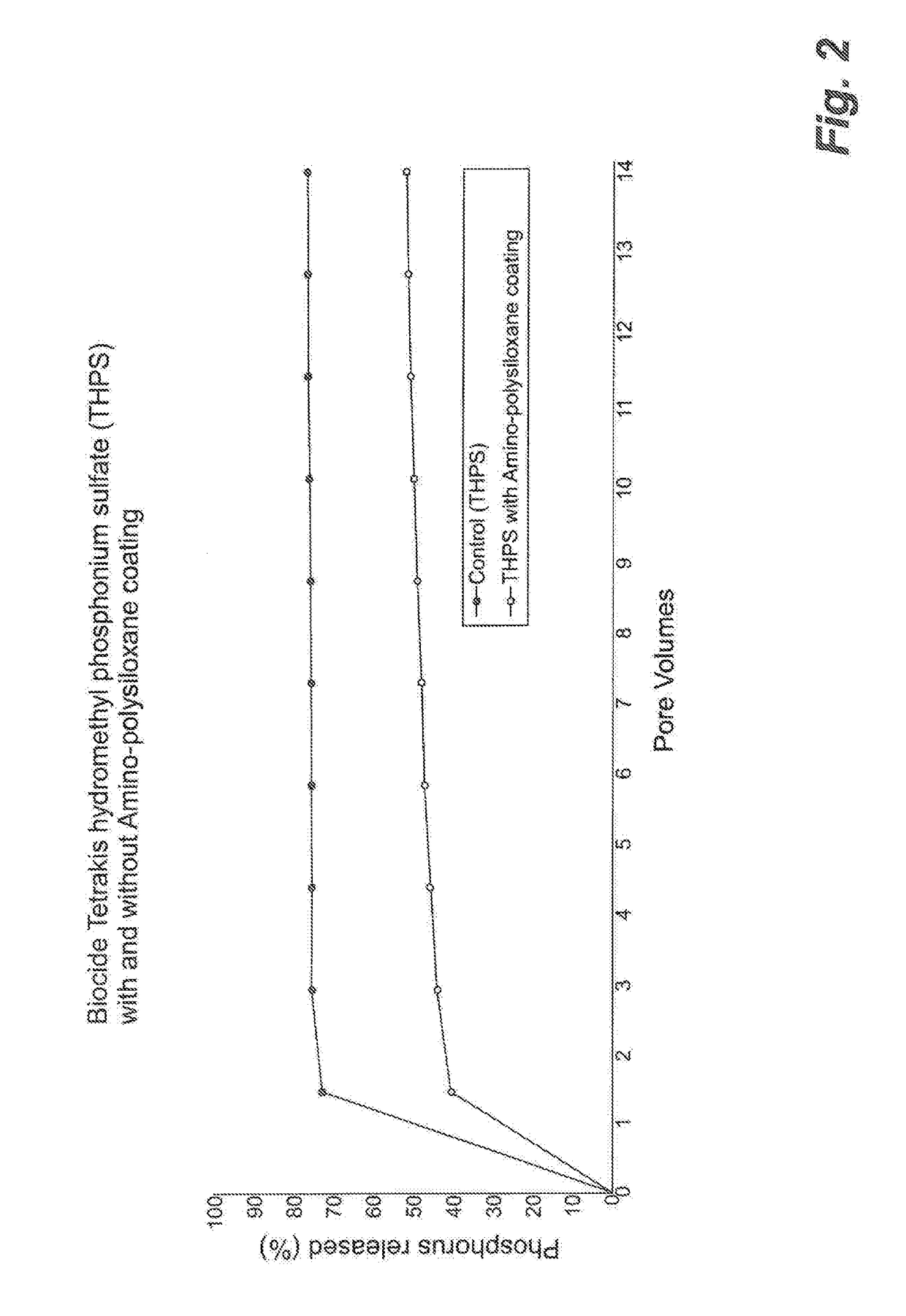Controlled release of chemicals in oilfield operations
a technology of oilfield operations and controlled release, applied in the field of oilfield operations, can solve the problems of affecting the production flow, affecting the release of chemicals, and relative poor suspension capability, and achieve the effect of delay or prolongation of the release of chemical additives
- Summary
- Abstract
- Description
- Claims
- Application Information
AI Technical Summary
Benefits of technology
Problems solved by technology
Method used
Image
Examples
example 1
[0101][Inorganic Scale Inhibitor 2-Phosphonic-1,2,4-Tricarboxylic Acid (PBTCA) with No Coating, as Control]
[0102]0.15 mL of PBTCA 62% aqueous solution was added to 150 gram of 20 / 40 US mesh sand and stirred. Then the sand was heated in an oven at 70° C. for 2 hours, after which it was packed in a glass column and tap water was flushed through by hydrostatic pressure. The effluent was collected and phosphorus concentration was determined by using Inductively Coupled Plasma Optical Emission Spectroscopy (ICP-OES). It was found that after 14 pore volumes of water, the amount of phosphorus on the proppant pack was depleted to 2 mg, from the initial 14.53 mg of phosphorus added, which represents 126.7 mg of the whole PBTCA molecule; this implies that 13.7% of the initial phosphorus remains available on the proppant pack for further release. Please refer to FIG. 1.
example 1a
[0103][Inorganic Scale Inhibitor 2-Phosphonic-1,2,4-Tricarboxylic Acid (PBTCA) with Amino-Polysiloxane Coating]
[0104]1.5 mL of 10 wt. % amino-polysiloxane (dimethyl, methyl(3-aminopropyl) siloxane, 3-aminopropylethoxymethylsiloxy-terminated) in mineral oil was mixed with 150 gram of 20 / 40 US mesh sand. The mixture was thoroughly stirred and then 0.15 mL of PBTCA 62% aqueous solution was added and it was stirred again. Then the coated sand was heated in an oven at 70° C. for 2 hours, after which it was packed in a glass column and tap water was flushed through by hydrostatic pressure. The effluent was collected and phosphorus concentration was determined by using Inductively Coupled Plasma Optical Emission Spectroscopy (ICP-OES). It was found that after 14 pore volumes of water, the amount of phosphorus on the proppant pack was depleted to 7 mg, from the initial 14.53 mg of phosphorus added, which represents 126.7 mg of the whole PBTCA molecule; this implies that 48% of the initial p...
example 1b
[0105][Inorganic Scale Inhibitor 2-Phosphonic-1,2,4-Tricarboxylic Acid (PBTCA) with Tung Oil Coating]
[0106]1.5 mL of 10 wt. % Tung Oil in mineral oil was mixed with 150 gram of 20 / 40 US mesh sand. The mixture was thoroughly stirred and then 0.15 mL of PBTCA 62% aqueous solution was added and stirred again. Then the coated sand was heated in an oven at 70° C. for 2 hours, after which it was packed in a glass column and tap water was flushed through by hydrostatic pressure. The effluent was collected and phosphorus concentration was determined by using Inductively Coupled Plasma Optical Emission Spectroscopy (ICP-OES). It was found that after 14 pore volumes of water, the amount of phosphorus on the proppant pack was depleted to 3.73 mg, from the initial 14.53 mg of phosphorus added, which represents 126.7 mg of the whole PBTCA molecule; this implies that 25.7% of the initial phosphorus remains available on the proppant pack for further release. Please refer to FIG. 1.
PUM
 Login to View More
Login to View More Abstract
Description
Claims
Application Information
 Login to View More
Login to View More - R&D
- Intellectual Property
- Life Sciences
- Materials
- Tech Scout
- Unparalleled Data Quality
- Higher Quality Content
- 60% Fewer Hallucinations
Browse by: Latest US Patents, China's latest patents, Technical Efficacy Thesaurus, Application Domain, Technology Topic, Popular Technical Reports.
© 2025 PatSnap. All rights reserved.Legal|Privacy policy|Modern Slavery Act Transparency Statement|Sitemap|About US| Contact US: help@patsnap.com



